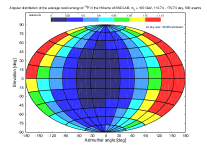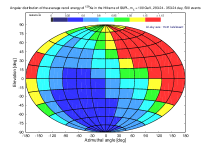Annual modulations of
the angular recoil–flux/energy distributions of
WIMP–scattered target nuclei
observed at an underground laboratory
Abstract
In this article, we compare the target and WIMP–mass dependent “annual modulations” of the angular distributions of the recoil flux and energy of WIMP–scattered target nuclei observed at different underground laboratories. For readers’ reference, simulation plots with different WIMP masses and frequently used target nuclei for all functionable underground laboratories can be found and downloaded on our online (interactive) demonstration webpage (http://www.tir.tw/phys/hep/dm/amidas-2d/).
1 Introduction
While most direct Dark Matter (DM) detection experiments measure only recoil energies of (elastic) WIMP–nucleus scattering events deposited in underground laboratory detectors, “directional” direct detection experiments aim to provide 3-dimensional information (recoil tracks and/or head–tail senses) of WIMP–scattered target nuclei, as a promising experimental strategy for discriminating WIMP signals from backgrounds [1, 2, 3] and some incoming–direction–known astronomical events [4].
Considering the very low theoretically estimated event rate and thus only a few (tens) of WIMP scattering events to be observed per year, instead of the originally proposed observation of the diurnal modulation in directional DM detection experiments, in Refs. [5, 6] we discussed and compared the annual modulations of the angular distributions of the 3-D velocity (flux) and (average) kinetic energy of Galactic halo WIMPs, which impinge on our detectors, observed at different underground laboratories. After that, in Refs. [7, 8] we finally accomplished our double Monte Carlo scattering–by–scattering simulation package for the 3-D elastic WIMP–nucleus scattering process and can provide the 3-D recoil direction and then the recoil energy of the WIMP–scattered target nuclei event by event in different celestial coordinate systems.
Hence, in this article, we will demonstrate and compare (the target and WIMP–mass dependences of) the annual modulations of the angular distributions of the recoil flux and the average recoil energy of scattered target nuclei observed at different underground laboratories.
2 Annual modulations of the angular recoil–flux/energy distributions in the horizontal frame
By using our simulation package described in detail in Ref. [7], in Figs. 1 we show the angular distributions of the recoil flux of nuclei scattered by 100-GeV WIMPs in four advanced seasons [9, 7] observed in the horizontal coordinate systems of the SUPL, the Kamioka, the LSC, the SNOLAB, and the ANDES laboratories, respectively111 Interested readers can click each row in Figs. 1 to 3 and Figs. 4 to 6 to open the webpage of the animated demonstration for the corresponding annual modulation (for more considered WIMP masses and target nuclei as well as other underground laboratories). . 5,000 experiments with 500 total accepted events on average (Poisson–distributed) in one experiment in each 60-day observation period of four advanced seasons have been simulated and binned into 12 12 bins.
Moreover, in Figs. 2 (and Figs. 3), we consider as one heavy target nucleus (and raise the simulated mass of incident WIMPs to GeV) in order to demonstrate the target (and the WIMP–mass) dependence(s) of the annual modulation of the angular recoil–flux distribution. Correspondingly, in Figs. 4, to 6 we show the angular distributions of the average recoil energy of and target nuclei scattered by 100- and 200-GeV WIMPs in four advanced seasons observed in the horizontal coordinate systems of five considered laboratories, respectively.
(a) 19.49 – 79.49 day (b) 110.74 – 170.74 day (c) 201.99 – 261.99 day (d) 293.24 – 353.24 day
(a) 19.49 – 79.49 day (b) 110.74 – 170.74 day (c) 201.99 – 261.99 day (d) 293.24 – 353.24 day
(a) 19.49 – 79.49 day (b) 110.74 – 170.74 day (c) 201.99 – 261.99 day (d) 293.24 – 353.24 day
(a) 19.49 – 79.49 day (b) 110.74 – 170.74 day (c) 201.99 – 261.99 day (d) 293.24 – 353.24 day
(a) 19.49 – 79.49 day (b) 110.74 – 170.74 day (c) 201.99 – 261.99 day (d) 293.24 – 353.24 day
(a) 19.49 – 79.49 day (b) 110.74 – 170.74 day (c) 201.99 – 261.99 day (d) 293.24 – 353.24 day
At first, in each row (for each laboratory), one can observe clearly the annual variations of the distribution patterns of both of the nuclear recoil flux and the average recoil energy. More precisely, the all–sky average value of the average recoil energy (Figs. 4 to 6) would be the largest (smallest) in the advanced summer (winter) for all considered laboratories (with all three considered target–WIMP mass combinations).
Furthermore, by comparing the distribution patterns of both of the nuclear recoil flux and the average recoil energy simulated with different target–WIMP mass combinations (for each laboratory), one can also find that the heavier the target nucleus and/or the mass of incident halo WIMPs, the wider the distribution patterns, since the larger the most frequent/energetic recoil angles (the angle between the nuclear recoil and the WIMP incoming velocity), caused by the stronger the cross section (nuclear form factor) suppression [8]. Hence, theoretically speaking, the 3-D distribution patterns of the nuclear recoil flux and, in particular, the average recoil energy would be useful for constraining (or even identifying) the mass (range) of halo WIMPs.

Finally, consider the LSC laboratory in the European (Eu) group as the comparison standard (the middle row of Figs. 1 to 6), as summarized in Fig. 7, it can be found that
-
•
the distribution patterns observed at Kamioka (the East–Asian (EAs) group) is similar but 3-month earlier;
-
•
the distributions observed at SNOLAB (the North–America (NAm) group) is also similar but 3-month later;
-
•
the distributions observed at SUPL (the South–Pacific (SPa) group) is similar to those observed at Kamioka but with a half–year difference and a 180∘–degree rotation;
-
•
the distributions observed at ANDES (the South–America (SAm) group) is similar to those observed at SNOLAB but also with a half–year difference and a 180∘–degree rotation;
-
•
the distributions observed at Kamioka and ANDES as well as those observed at SUPL and SNOLAB are similar in the same seasons but with a 180∘–degree rotation.
Note however that, while the angular distribution patterns of the 3-D recoil flux and the (average) recoil energy vary from laboratory to laboratory (due to their geographical locations), the all–sky average values of the average recoil energy (simulated with each target–WIMP mass combination) measured at different laboratories in the same season (observation period) should be (almost) equal!
3 Conclusions
In this article, we have demonstrated and compared the (target and WIMP–mass dependent) annual modulations of the angular recoil–flux/energy distributions of WIMP–scattered target nuclei observed at different underground laboratories. Hopefully, this work could be useful for our colleagues working on directional direct Dark Matter detection physics.
Acknowledgments
The author would like to thank the pleasant atmosphere of the W101 Ward and the Cancer Center of the Kaohsiung Veterans General Hospital, where part of this work was completed. This work was strongly encouraged by the “Researchers working on e.g. exploring the Universe or landing on the Moon should not stay here but go abroad.” speech.
References
References
- [1] S. Ahlen et al. 2010 The Case for a Directional Dark Matter Detector and the Status of Current Experimental Efforts Int. J. Mod. Phys. A25 1–51 (Preprint 0911.0323)
- [2] F. Mayet et al. 2016 A Review of the Discovery Reach of Directional Dark Matter Detection Phys. Rept. 627 1–49 (Preprint 1602.03781)
- [3] S. E. Vahsen, C. A. J. O’Hare and D. Loomba 2021 Directional Recoil Detection Ann. Rev. Nucl. Part. Sci. 71 189–224 (Preprint 2102.04596)
- [4] M. Heikinheimo, N. Mirabolfathi, K. Nordlund, S. Sassi and K. Tuominen 2021 Solar Neutrinos and Dark Matter Detection with Diurnal Modulation Phys. Rev. D104 063037 (Preprint 2103.08511)
- [5] Shan C-L 2020 Annual and Diurnal Modulations of the Angular Distribution of the 3-D WIMP Velocity Observed at an Underground Laboratory J. Phys.: Conf. Ser. 1468 012017 (Preprint 1910.11763)
- [6] Shan C-L 2020 Simulations of the Angular Kinetic–Energy Distribution of Halo Weakly Interacting Massive Particles for Directional Dark Matter Detection Experiments in publication
- [7] Shan C-L 2021 Monte Carlo Scattering–by–Scattering Simulation of 3-Dimensional Elastic WIMP–Nucleus Scattering Events (Preprint 2103.06485) in publication
- [8] Shan C-L 2021 Simulations of the Angular Recoil–Energy Distribution of WIMP–Scattered Target Nuclei for Directional Dark Matter Detection Experiments (Preprint 2103.06486) in publication
- [9] Shan C-L 2019 Simulations of the 3-Dimensional Velocity Distribution of Halo Weakly Interacting Massive Particles for Directional Dark Matter Detection Experiments (Preprint 1905.11279) in publication























































































































